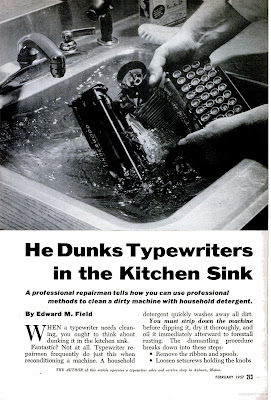The Hammond typewriter uses two wear-items; the impression strip and the ribbon shield. These two items were originally sold at modest cost by the Hammond Typewriter Company. The ribbon shield is essential to print cleanly without smudging by adjacent characters. The impression strip is important to even-out and dampen the impact of the steel hammer through the paper onto the hard-rubber type-shuttle. As is advised by several sources; Do not type on a Hammond without impression strip!
From literature and some pictures found online of surviving originals, these strips were probably made of rubber vulcanised onto a cloth base. The reinforced ends have holes that allow the strip to be stretched over the pins of the typewriter's carriage.
After making several new ribbon-shields, the second wear-item -the impression strip- is relatively straightforward to make.
Because there may be some variation between machines in the actual distance between the pins, start with measuring this span. Also the vertical pitch in case of two pins. Drawing these dimensions on a sheet of paper (or card) gives the template for making new impression strips.
Several materials can be used to create new impression strips, e.g. cutting to length from 1mm rubber sheet ~15mm wide. For reinforcing the ends thin aluminium sheet (e.g. scraps from making the ribbon-shield) or metal-tape can be glued to the rubber - these help with the appearance and strength of the ends.
Punch the holes (~3mm) at a few mm less than the span of the pins on the template to give the strip some tension. This then quickly makes new 'platens' for the Hammond.
The more fancy (and easier) way is to use electrical- or insulation-tape. This is low-cost and available in colours too (fancy impression strips!). This material is 'stretchy' and will cushion the impact of the steel hammer similar to rubber. Because it is 'stretchy', reinforcing the ends is essential. Otherwise the holes will distort and the strip will crease. For this, simple card-scraps are included in the 'tape-sandwich'. For extra strength and to further limit the risk of creasing, a cloth ribbon is added in the middle of the strip. (As bonus, a cloth-core is also prototypical :-)
To start with, a length of black 15mm wide electrical-tape is itself taped over the template, adhesive-side up. The card end-pieces are pasted in-place on the tape, again allowing a few mm for tension when mounted on the pins. The end-pieces have the holes and the desired outline marked in black (i.e. in high contrast).
To suit the desired 'weight' of the strip, one or more extra lengths of electrical tape can be very carefully placed over the base-layer between the card end-pieces - again adhesive-side up. Take care to let the tape 'recover' after tearing off a length and before adding it to the strip being formed. It is a slow-deforming material, it does 'relax'.
In the same way, a length of cloth ribbon is placed on the black tape between the end-pieces. Also here do not stretch it, but place it onto the stack without tension.
Unless the cloth ribbon is exactly same width as the tape, cut away the excess width. Either now as or later as a last step, cut away any ribbon that protrudes over the sides. If using a scalpel with a ruler, use very light pressure and multiple passes to cut - the strip is elastic and would otherwise deform and mess-up the straight cut. Scissors will work too.
To add the back of the strip, one or more layers of another color electrical tape - adhesive-side down of course. In this case brown. The reason for using a color is that these are translucent and the outline and location of the holes can still be seen.
With hole-punches and scissors the ends are cut to the desired pattern. (Hole-punches are by the way surprisingly expensive, but also surprisingly one of the more useful tools for this tinkering around typewriters.)
This type of tip is much fancier than the square-ended original Hammond impression strips. It does however look 'nice' and ornamental, in keeping with the machine itself. Also, the fancy-ends pull-tabs could be justified by saying these make mounting of the strips easier ;-)
It remains to be seen how well the electrical tape stands up to the striking of the hammer over time.
In case this impression strip wears quickly (although a Hammond of this vintage is today not a machine to be used extensively), it is easy and low-cost to make several spares. Variations with different thicknesses are also easy to prepare.
(Also duct-tape was tried as ingredient for making an impression strip, this however was not ideal. The weave-texture does not help with clean impressions and duct-tape is prone to creasing under tension.)



























